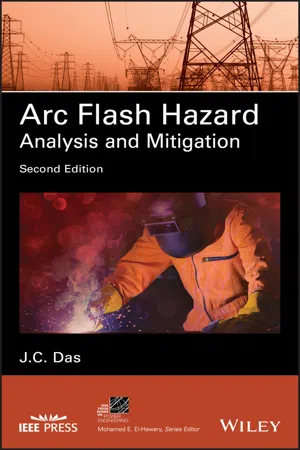
- English
- ePUB (mobile friendly)
- Available on iOS & Android
Arc Flash Hazard Analysis and Mitigation
About this book
This new edition of the definitive arc flash reference guide, fully updated to align with the IEEE's updated hazard calculations
An arc flash, an electrical breakdown of the resistance of air resulting in an electric arc, can cause substantial damage, fire, injury, or loss of life. Professionals involved in the design, operation, or maintenance of electric power systems require thorough and up-to-date knowledge of arc flash safety and prevention methods. Arc Flash Hazard Analysis and Mitigation is the most comprehensive reference guide available on all aspects of arc flash hazard calculations, protective current technologies, and worker safety in electrical environments. Detailed chapters cover protective relaying, unit protection systems, arc-resistant equipment, arc flash analyses in DC systems, and many more critical topics.
Now in its second edition, this industry-standard resource contains fully revised material throughout, including a new chapter on calculation procedures conforming to the latest IEEE Guide 1584. Updated methodology and equations are complemented by new practical examples and case studies. Expanded topics include risk assessment, electrode configuration, the impact of system grounding, electrical safety in workplaces, and short-circuit currents. Written by a leading authority with more than three decades' experience conducting power system analyses, this invaluable guide:
- Provides the latest methodologies for flash arc hazard analysis as well practical mitigation techniques, fully aligned with the updated IEEE Guide for Performing Arc-Flash Hazard Calculations
- Explores an inclusive range of current technologies and strategies for arc flash mitigation
- Covers calculations of short-circuits, protective relaying, and varied electrical system configurations in industrial power systems
- Addresses differential relays, arc flash sensing relays, protective relaying coordination, current transformer operation and saturation, and more
- Includes review questions and references at the end of each chapter
Part of the market-leading IEEE Series on Power Engineering, the second edition of Arc Flash Hazard Analysis and Mitigation remains essential reading for all electrical engineers and consulting engineers.
Frequently asked questions
- Essential is ideal for learners and professionals who enjoy exploring a wide range of subjects. Access the Essential Library with 800,000+ trusted titles and best-sellers across business, personal growth, and the humanities. Includes unlimited reading time and Standard Read Aloud voice.
- Complete: Perfect for advanced learners and researchers needing full, unrestricted access. Unlock 1.4M+ books across hundreds of subjects, including academic and specialized titles. The Complete Plan also includes advanced features like Premium Read Aloud and Research Assistant.
Please note we cannot support devices running on iOS 13 and Android 7 or earlier. Learn more about using the app.
Information
1
ARC FLASH HAZARDS AND THEIR ANALYSES
Table of contents
- COVER
- TABLE OF CONTENTS
- TITLE PAGE
- COPYRIGHT PAGE
- FOREWORD
- PREFACE TO SECOND EDITION
- PREFACE TO FIRST EDITION
- ACKNOWLEDGEMENT
- ABOUT THE AUTHOR
- 1 ARC FLASH HAZARDS AND THEIR ANALYSES
- 2 SAFETY AND PREVENTION THROUGH DESIGN: A NEW FRONTIER
- 3 CALCULATIONS ACCORDING TO IEEE GUIDE 1584, 2018
- 4 ARC FLASH HAZARD AND SYSTEM GROUNDING
- 5 SHORT-CIRCUIT CALCULATIONS ACCORDING TO ANSI/IEEE STANDARDS FOR ARC FLASH ANALYSIS
- 6 ACCOUNTING FOR DECAYING SHORT-CIRCUIT CURRENTS IN ARC FLASH CALCULATIONS
- 7 PROTECTIVE RELAYING
- 8 UNIT PROTECTION SYSTEMS
- 9 ARC FAULT DETECTION RELAYS
- 10 OVERCURRENT COORDINATION
- 11 TRANSFORMER PROTECTION
- 12 CURRENT TRANSFORMERS
- 13 ARC-RESISTANT EQUIPMENT
- 14 RECENT TRENDS AND INNOVATIONS
- 15 ARC FLASH HAZARD CALCULATIONS IN DC SYSTEMS
- 16 APPLICATION OF ETHERNET AND IEC 61850 COMMUNICATIONS
- APPENDIX A:: APPENDIX A:STATISTICS AND PROBABILITY APPLIED TO ELECTRICAL ENGINEERING
- APPENDIX B:: APPENDIX B:TABLES FOR QUICK ESTIMATION OF INCIDENT ENERGY AND PPE IN ELECTRICAL SYSTEMS
- INDEX
- IEEE PRESS SERIES ON POWER ENGINEERING
- END USER LICENSE AGREEMENT